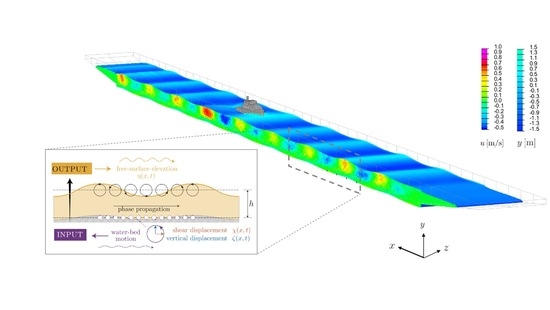Generation of Gravity Waves by Pedal-Wavemakers
Abstract
:1. Introduction
2. Methods
2.1. Wave Generation Using a Hinged-Paddle with SPH Simulations
2.2. The Pedal-Wavemaking Technique
2.3. Theoretical Model
3. Results
3.1. SPH Simulations of Regular Wave Generation by Hinged Paddles
3.2. Generation of Long Waves by Pedal Wavemakers
3.3. Emulating Deep-Water Waves in a Wave Tank
3.4. Linearised Hydrodynamic Equations in the Long-Wavelength Limit
4. Discussion
5. Conclusions
Supplementary Materials
Author Contributions
Funding
Institutional Review Board Statement
Informed Consent Statement
Data Availability Statement
Conflicts of Interest
References
- Cross, M.; Greenside, H. Pattern Formation and Dynamics in Nonequilibrium Systems; Cambridge University Press: Cambridge, UK, 2009. [Google Scholar]
- Lighthill, J. Waves in Fluids; Cambridge University Press: Cambridge, UK, 1978. [Google Scholar]
- Grilli, S.T.; Harris, J.C.; Bakhsh, T.S.T.; Masterlark, T.L.; Kyriakopoulos, C.; Kirby, J.T.; Shi, F. Numerical simulation of the 2011 Tohoku tsunami based on a new transient FEM co-seismic source: Comparison to far-and near-field observations. Pure Appl. Geophys. 2013, 170, 1333–1359. [Google Scholar] [CrossRef]
- Jamin, T.; Gordillo, L.; Ruiz-Chavarría, G.; Berhanu, M.; Falcon, E. Experiments on generation of surface waves by an underwater moving bottom. Proc. R. Soc. A Math. Phys. Eng. Sci. 2015, 471, 20150069. [Google Scholar] [CrossRef] [Green Version]
- Cunningham, L.S.; Rogers, B.D.; Pringgana, G. Tsunami wave and structure interaction: An investigation with smoothed-particle hydrodynamics. Proc. Inst. Civ. Eng. Eng. Comput. Mech. 2014, 167, 126–138. [Google Scholar] [CrossRef] [Green Version]
- Groenenboom, P.H.; Cartwright, B.K. Hydrodynamics and fluid-structure interaction by coupled SPH-FE method. J. Hydraul. Res. 2010, 48, 61–73. [Google Scholar] [CrossRef]
- Cartwright, B.K. The Study of Ship Motions in Regular Waves Using a Mesh-Free Numerical Method. Master’s Thesis, University of Tasmania, Hobart, Australia, 2012. [Google Scholar]
- Lloyd, A.R.J.M.; Hosoda, R.; Robinson, D.W.; Nicholson, K.; Victory, G.; Price, W.G.; Bishop, R.E.D.; Price, W.G. Seakeeping. Philos. Trans. R. Soc. London Ser. A Phys. Eng. Sci. 1991, 334, 253–264. [Google Scholar] [CrossRef]
- Li, S.; Liu, W.K. Meshfree and particle methods and their applications. Appl. Mech. Rev. 2002, 55, 1–34. [Google Scholar] [CrossRef]
- Liu, G.R.; Liu, M.B. Smoothed Particle Hydrodynamics: A Meshfree Particle Method; World Scientific: Singapore, 2003. [Google Scholar]
- Sigalotti, L.D.G.; Klapp, J.; Sira, E.; Meleán, Y.; Hasmy, A. SPH simulations of time-dependent Poiseuille flow at low Reynolds numbers. J. Comput. Phys. 2003, 191, 622–638. [Google Scholar] [CrossRef]
- Liu, M.B.; Liu, G.R. Smoothed Particle Hydrodynamics (SPH): An Overview and Recent Developments. Arch. Comput. Methods Eng. 2010, 17, 25–76. [Google Scholar] [CrossRef] [Green Version]
- Wang, Z.B.; Chen, R.; Wang, H.; Liao, Q.; Zhu, X.; Li, S.Z. An overview of smoothed particle hydrodynamics for simulating multiphase flow. Appl. Math. Model. 2016, 40, 9625–9655. [Google Scholar] [CrossRef]
- Sigalotti, L.D.G.; López, H.; Trujillo, L. An adaptive SPH method for strong shocks. J. Comput. Phys. 2009, 228, 5888–5907. [Google Scholar] [CrossRef]
- Sigalotti, L.D.G.; López, H.; Donoso, A.; Sira, E.; Klapp, J. A shock-capturing SPH scheme based on adaptive kernel estimation. J. Comput. Phys. 2006, 212, 124–149. [Google Scholar] [CrossRef]
- Marrone, S.; Antuono, M.; Colagrossi, A.; Colicchio, G.; Touzé, D.L.; Graziani, G. δ-SPH model for simulating violent impact flows. Comput. Methods Appl. Mech. Eng. 2011, 200, 1526–1542. [Google Scholar] [CrossRef]
- Sun, P.; Colagrossi, A.; Marrone, S.; Antuono, M.; Zhang, A. Multi-resolution Delta-plus-SPH with tensile instability control: Towards high Reynolds number flows. Comput. Phys. Commun. 2018, 224, 63–80. [Google Scholar] [CrossRef]
- De Padova, D.; Mossa, M.; Sibilla, S. Characteristics of nonbuoyant jets in a wave environment investigated numerically by SPH. Environ. Fluid Mech. 2020, 20, 189–202. [Google Scholar] [CrossRef]
- Meleán, Y.; Sigalotti, L.D.G.; Hasmy, A. On the SPH tensile instability in forming viscous liquid drops. Comput. Phys. Commun. 2004, 157, 191–200. [Google Scholar] [CrossRef]
- Meleán, Y.; Sigalotti, L.D.G. Coalescence of colliding van der Waals liquid drops. Int. J. Heat Mass Transf. 2005, 48, 4041–4061. [Google Scholar] [CrossRef]
- Ming, F.; Sun, P.; Zhang, A. Numerical investigation of rising bubbles bursting at a free surface through a multiphase SPH model. Meccanica 2017, 52, 2665–2684. [Google Scholar] [CrossRef]
- Gnanasekaran, B.; Liu, G.R.; Fu, Y.; Wang, G.; Niu, W.; Lin, T. A Smoothed Particle Hydrodynamics (SPH) procedure for simulating cold spray process—A study using particles. Surf. Coat. Technol. 2019, 377, 124812. [Google Scholar] [CrossRef]
- Sigalotti, L.D.G.; López, H. Adaptive kernel estimation and SPH tensile instability. Comput. Math. Appl. 2008, 55, 23–50. [Google Scholar] [CrossRef] [Green Version]
- Milgram, J.H. Active water-wave absorbers. J. Fluid Mech. 1970, 42, 845–859. [Google Scholar] [CrossRef]
- Schäffer, H.A.; Klopman, G. Review of Multidirectional Active Wave Absorption Methods. J. Waterw. Port C ASCE 2000, 126, 88–97. [Google Scholar] [CrossRef]
- Ouellet, Y.; Datta, I. A survey of wave absorbers. J. Hydraul. Res. 1986, 24, 265–280. [Google Scholar] [CrossRef]
- Havelock, T. Forced surface-waves on water. Lond. Edinb. Dubl. Phil. Mag. 1929, 8, 569–576. [Google Scholar] [CrossRef]
- Ba Thuy, N.; Tanimoto, K.; Tanaka, N.; Harada, K.; Iimura, K. Effect of open gap in coastal forest on tsunami run-up - investigations by experiment and numerical simulation. Ocean. Eng. 2009, 36, 1258–1269. [Google Scholar] [CrossRef]
- Briggs, M.J.; Synolakis, C.E.; Harkins, G.S.; Green, D.R. Laboratory experiments of tsunami runup on a circular island. Pure Appl. Geophys. 1995, 144, 569–593. [Google Scholar] [CrossRef]
- Dematteis, G.; Grafke, T.; Onorato, M.; Vanden-Eijnden, E. Experimental Evidence of Hydrodynamic Instantons: The Universal Route to Rogue Waves. Phys. Rev. X 2019, 9, 041057. [Google Scholar] [CrossRef] [Green Version]
- McAllister, M.L.; Draycott, S.; Adcock, T.A.A.; Taylor, P.H.; van den Bremer, T.S. Laboratory recreation of the Draupner wave and the role of breaking in crossing seas. J. Fluid Mech. 2019, 860, 767–786. [Google Scholar] [CrossRef] [Green Version]
- Ursell, F.; Dean, R.G.; Yu, Y.S. Forced small-amplitude water waves: A comparison of theory and experiment. J. Fluid Mech. 1960, 7, 33–52. [Google Scholar] [CrossRef]
- Dean, R.G.; Dalrymple, R.A. Water Wave Mechanics for Engineers and Scientists; World Scientific Publishing Company: Singapore, 1991; Volume 2. [Google Scholar]
- Ozbulut, M.; Ramezanzadeh, S.; Yildiz, M.; Goren, O. Modelling of wave generation in a numerical tank by SPH method. J. Ocean. Eng. Mar. Energy 2020, 6, 121–136. [Google Scholar] [CrossRef]
- Stoker, J.J. Water Waves: The Mathematical Theory with Applications; John Wiley & Sons: Hoboken, NJ, USA, 2011; Volume 36. [Google Scholar]
- Lamb, H.L. Hydrodynamics; Cambridge University Press: Cambridge, UK, 1932. [Google Scholar]
- Kajiura, K. The leading wave of a tsunami. B. Earthq. Res. I. Tokyo 1963, 41, 535–571. [Google Scholar]
- Munk, W. Origin and generation of waves. Coast. Eng. Proc. 1950, 1, 1. [Google Scholar] [CrossRef] [Green Version]
- McCue, L.; Alford, L.; Belknap, W.; Bulian, G.; Delorme, L.; Francescutto, A.; Vakakis, A. An overview of the minisymposium on extreme ship dynamics presented at the 2005 SIAM conference on applications of dynamical systems. Mar. Technol. 2006, 43, 55–61. Available online: https://onepetro.org/journal-paper/SNAME-MTSN-2006-43-1-55 (accessed on 1 March 2021).
- Jones, D.A.; Belton, D. Smoothed Particle Hydrodynamics: Applications within DSTO; Technical Report; Defence Science Technology Organisation: Australia, 2006; Available online: https://apps.dtic.mil/sti/pdfs/ADA463727.pdf (accessed on 1 March 2021).
- Guilcher, P.; Ducorzet, G.; Alessandrini, B.; Ferrant, P. Water wave propagation using SPH models. In Proceedings of the 2nd International SPHERIC Workshop, Madrid, Spain, 23–25 May 2007; pp. 119–124. [Google Scholar]
- De Padova, D.; Dalrymple, R.; Mossa, M.; Petrillo, A. SPH simulations of regular and irregular waves and their comparison with experimental data. arXiv 2009, arXiv:0911.1872. [Google Scholar]


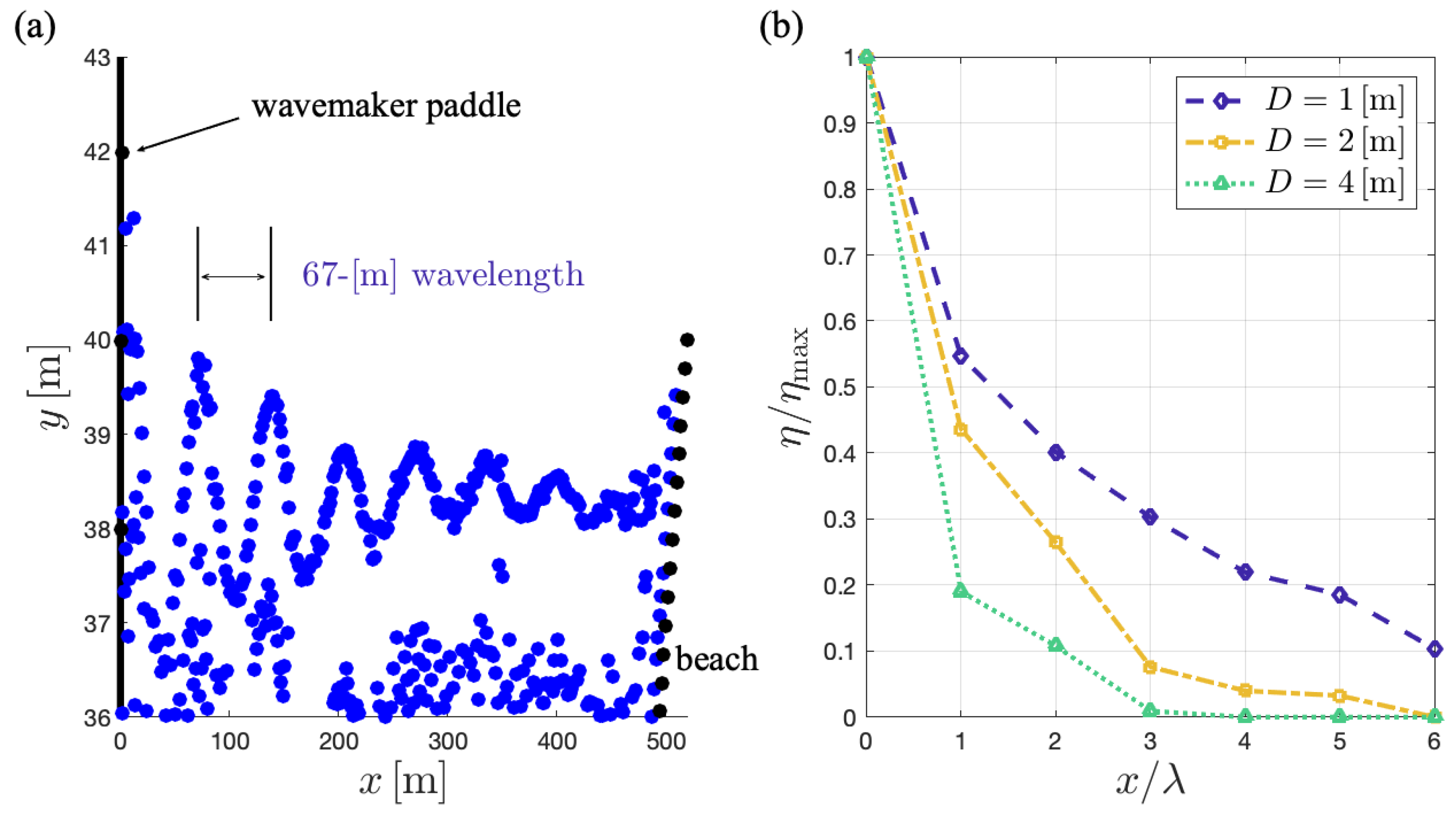
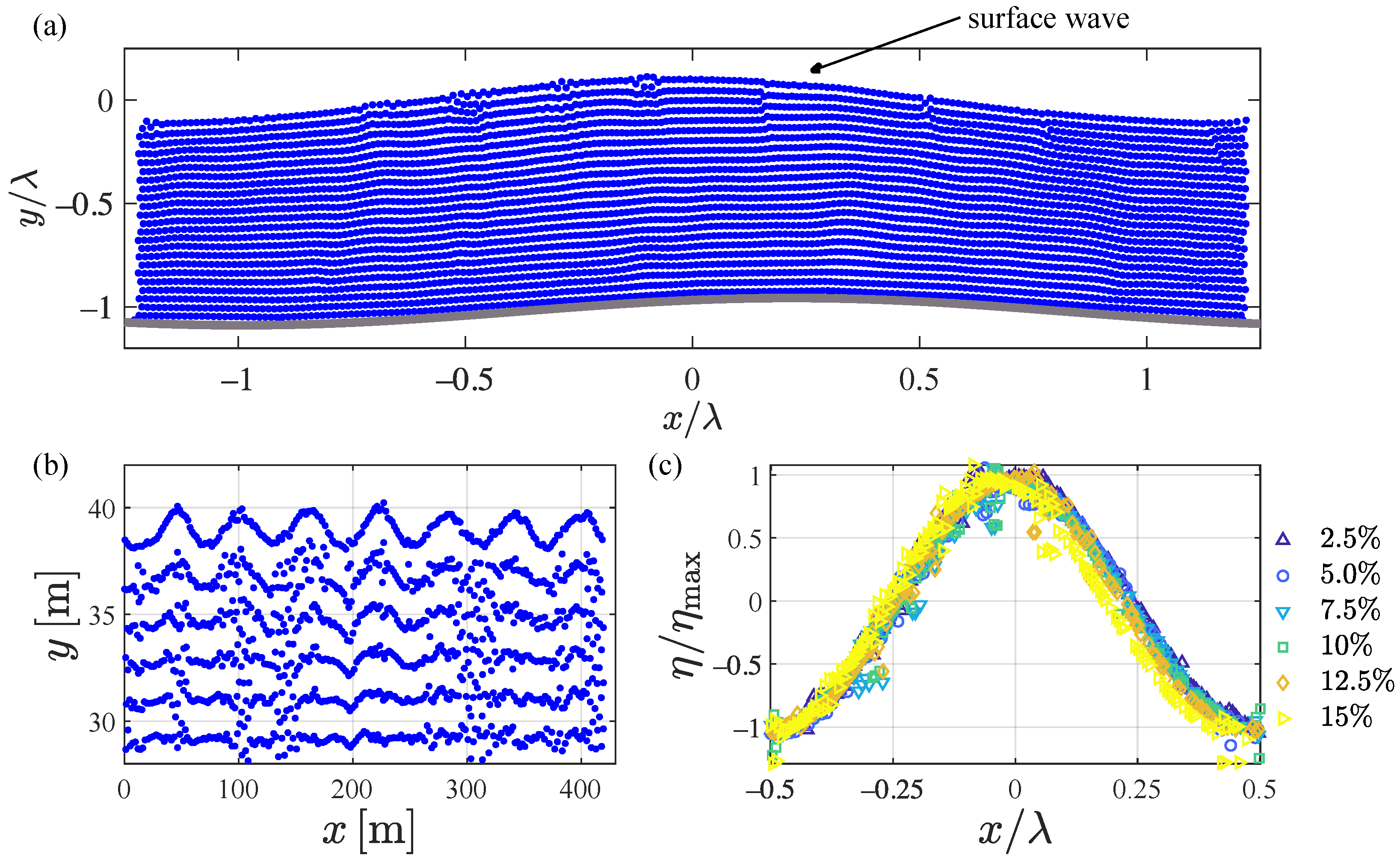
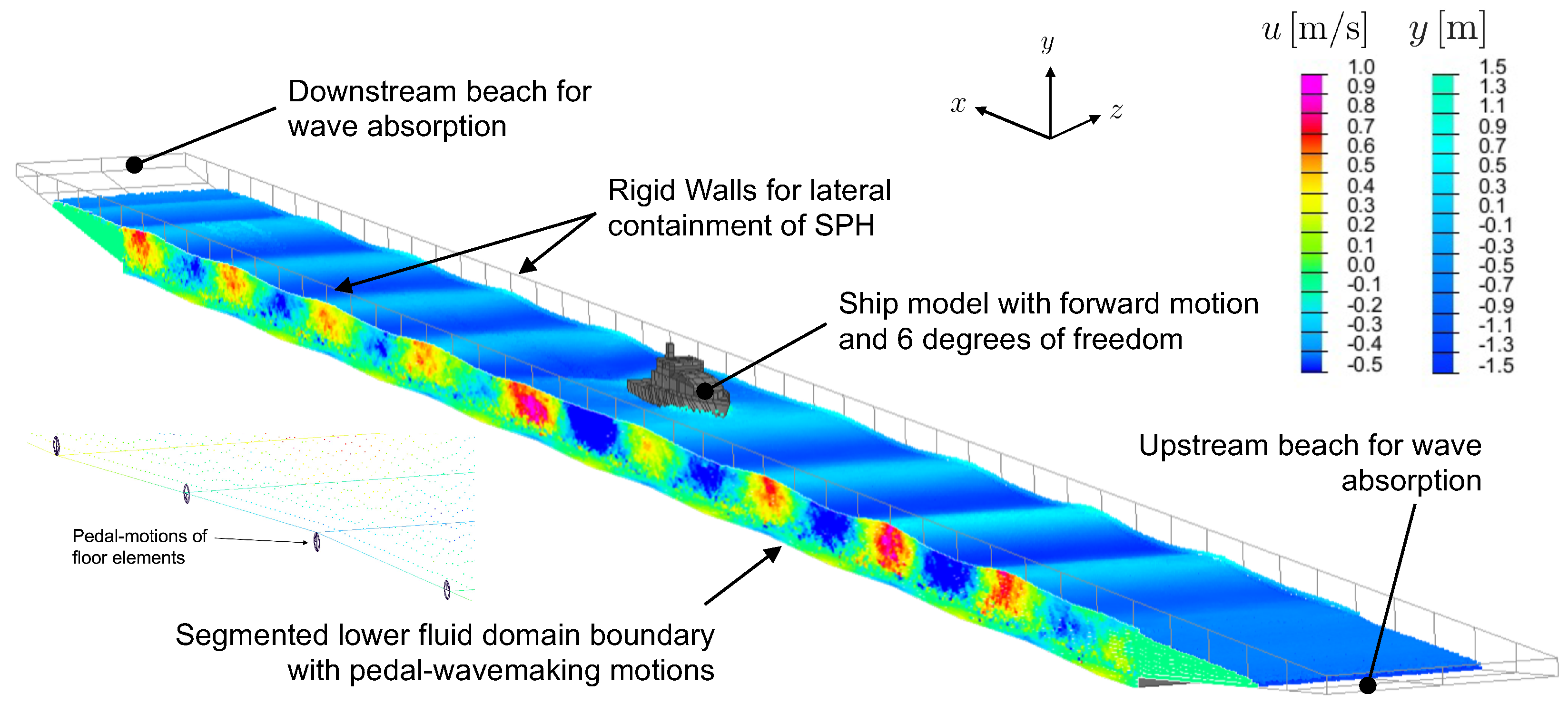
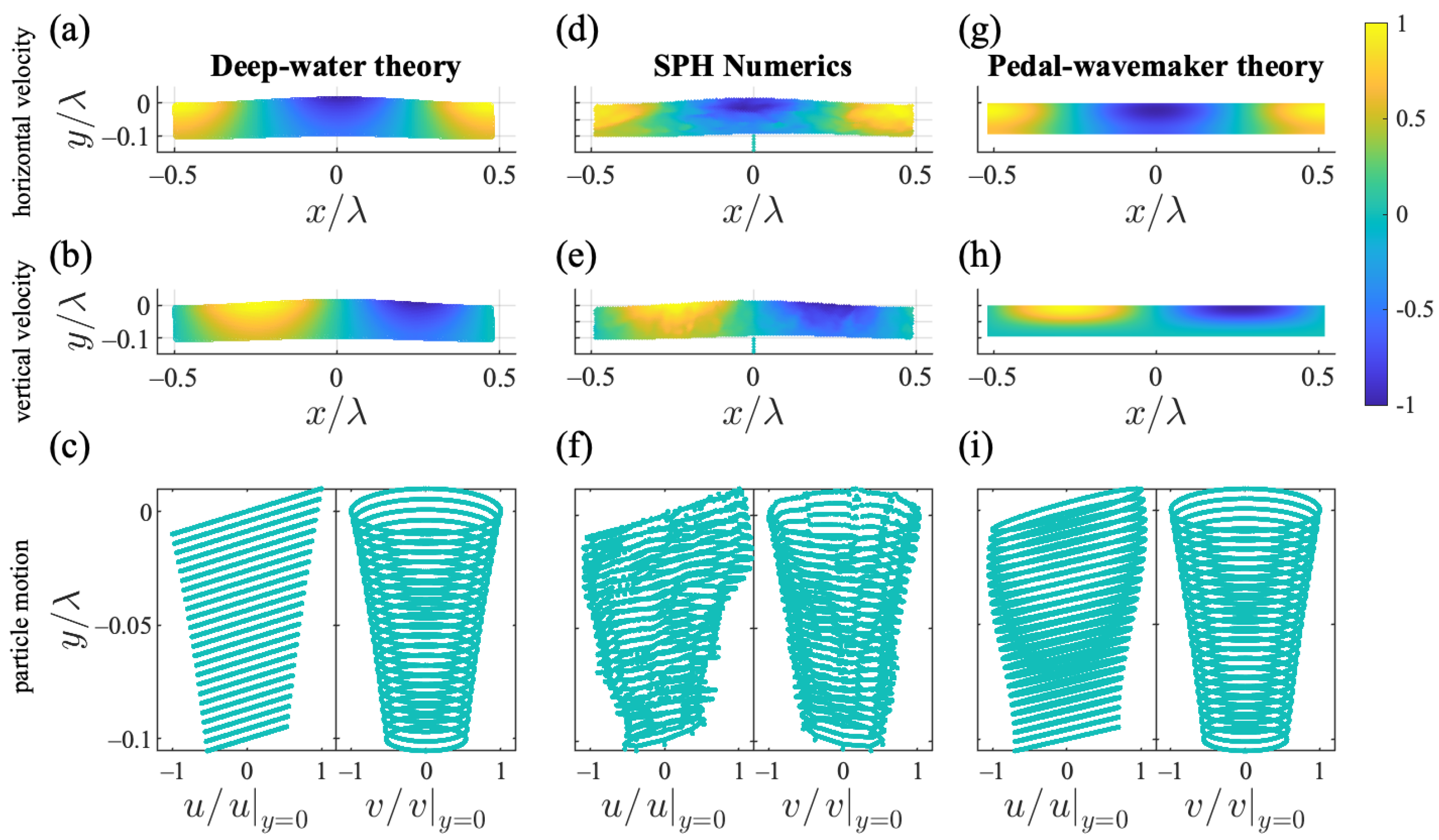

Publisher’s Note: MDPI stays neutral with regard to jurisdictional claims in published maps and institutional affiliations. |
© 2021 by the authors. Licensee MDPI, Basel, Switzerland. This article is an open access article distributed under the terms and conditions of the Creative Commons Attribution (CC BY) license (https://creativecommons.org/licenses/by/4.0/).
Share and Cite
Vivanco, I.; Cartwright, B.; Ledesma Araujo, A.; Gordillo, L.; Marin, J.F. Generation of Gravity Waves by Pedal-Wavemakers. Fluids 2021, 6, 222. https://doi.org/10.3390/fluids6060222
Vivanco I, Cartwright B, Ledesma Araujo A, Gordillo L, Marin JF. Generation of Gravity Waves by Pedal-Wavemakers. Fluids. 2021; 6(6):222. https://doi.org/10.3390/fluids6060222
Chicago/Turabian StyleVivanco, Isis, Bruce Cartwright, A. Ledesma Araujo, Leonardo Gordillo, and Juan F. Marin. 2021. "Generation of Gravity Waves by Pedal-Wavemakers" Fluids 6, no. 6: 222. https://doi.org/10.3390/fluids6060222






